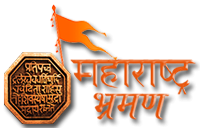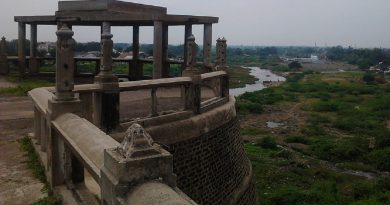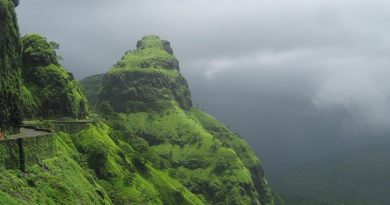Mulher Fort
The North-South stretch of Sahyadri originates in the Baglan region of Nashik. The North of Sahyadri, in the Baglan region, has got dual ranges, Selbari – Dolbari. Forts like Tambolya, Nhavigad, Pinnacles of Mangi and Tungi lie on Selbari range while Mulher, Moragad, Salher, Hargad, Salota lie in Dolbari range. These forts lie on the border of Dang region, a dense forest, in the West of Gujarat and Baglan region in Maharashtra.
The other name of Baglan is ‘Bagulged’. There is a mixed impact of Gujarat and Maharashtra on the living-style of residents, as the region is on the border of these States. The land of this region is very fertile, making people to adopt farming as their occupation. Plenty of water makes this region fully flourished and rich.
In the Satana Taluka of Nashik district, lies the fort of Mulher. There is a Mulher village at the foot-hills of this fort.
Type : Hill forts.
Fort Range : Dolbari.
District : Nashik.
History :
In ancient times, the village was located on the Mulher fort. In due course of period the villagers descended and Mulher village is now situated at foothills 2 kms. away from the fort. The village belongs to the period of Mahabharata, when it was known as Ratnapur. The King, Mayurdhwaj ruled this region, and the village was then named as Mayurpur. When Aurangazeb conquered this fort, the fort came into existence with the name as Aurangagad.
The citations of Mulher can be found in the first decade of fourteenth century, while ‘Puranas’ are believed to have few mentions of it. The fort was built by Bagul dynasty, who ruled the region from 1308 A.D. to 1619 A.D. The region was named Bagulged because of the rule of Bagul dynasty, which afterwards came to be known as Baglan. Basically, Bagul dynasty belonged to Kanoj. Eleven Kings of this dynasty ruled the Baglan region. These Kings were awarded the Degree of Bahirji. It was during the rule of this dynasty, the world-famous ‘Mulheri Muth’, the sword-handle, was made. Hinduism was established in this region much before than that in Vijaynagar.
When Akbar conquered Khandesh, Pratapshaha Bahirji, the then King of Baglan, surrendered to Mughals. He established friendly relations with Shahajahan. In 1636, Aurangazeb was appointed as the Governor of Western region. In 1638 Mughals invaded Baglan and conquered it, after which the fort was named as Aurangagad. This attack ended the prosperous Hindu rule in Baglan. Mulher had been the Capital of Baglan for all the times. Mohammed Tahir was appointed as the first Killedar on the fort. He established Tahirabad, a village near Mulher, which was initially known as Tahir. In 1662, a strike was called off by soldiers on the fort for scarce salary. After the second loot over Surat, Shivaji Maharaj commenced the Baglan campaign. In 1671, Marathas first attacked the Mulher fort, but the Killedar could repulse the attack. Then in February 1672, Marathas first captured Salher fort and then attacked the Mulher fort too. In this campaign, Shivaji Maharaj could assimilate the forts like Salher, Mulher, etc. in the Maratha Kingdom. Afterwards, the fort of Mulher was again conquered by Mughals.
According to the treaty of Bhalki in 1752, the whole region of Khandesh, alongwith Mulher, was handed over to Marathas. Some hidden treasure is supposedly found in 1765, according to the citations in the accounts-books of Peshwe. In 1818, the fort was brought under the rule of British.
Fascinating Spots :
Ganesh Mandir :
The fort is mainly divided in two parts, the Mulher Machi (flat plateau) and the Bale-Killa (Citadel). The temple of Lord Ganesha is situated on the Mulher Machi.
Someshwar Mandir and Chandan Bav :
From Ganesh Mandir, two ways emerge out. The one towards left leads to Someshwar Mandir, a temple of Lord Shiva. On the way to Someshwar temple lies a three-storey Well, known as Chandan Bav.
Moti Tank :
Trailing back from Someshwar temple, we come across a bifurcation. We follow the straight route and reach the plateau from where we can reach Moti Tank, a cool drinking-water cistern.
Rajwada and Ram-Laxman Mandir :
Following the straight path from the plateau, we reach at Rajwada, a Palace, of which only remnants could be seen. Near the Palace, through the thick undergrowth we reach the famous Ram-Laxman temple.
Bale-Killa :
Through the right-way from Moti tank, we reach at the Maha-Darwaja of Citadel. Stepping in we can see a cistern to the right, while a cave to the left of it. On the plateau of Citadel, we can see temple of Lord Bhadangnath, 9 -10 cisterns, palatial remnants, etc. On climbing the small hill above the Bhadangnath temple and trailing down the other side, the forts like Mora, Nhavigad, Tambolya, Hanumangad, as also the pinnacles of Mangi-Tungi are worth seeing.
Ways To Reach :
There are two ways to reach the Mulher fort, both of which begins from the Mulher village, 2 k.m. away from the fort. Walking for about 25 minutes from the Mulher village, a house can be located on the left hand side and a Banyan tree in the front. Moving ahead by the side of Banyan tree, after 10 minutes of walk, we reach Dhangarwadi. At a 45 minutes of walking distance from Dhangarwadi, two ways are seen, the one going straight and the other turning to right.
The Straight Route :
From this route we reach the Ganesh Temple on Mulher Machi within 20 minutes. This route is quite easier. We come across three entrance doors, which are now in demolished state.
The Route towards Right :
Following this route, we can reach Ganesh Temple on Mulher Machi in about two hours. The three entrance doors are also located along this route. This route leads us through the cleft between Hargad and Mulher fort. The way on the right goes to Hargad and on the left to Mulher fort.




